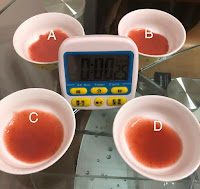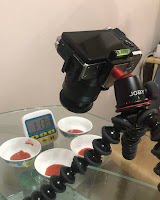Final experiment by Chan Kwan To (3035691353)
How do the ingredients affect the shelf life of vinaigrette?
Introduction
Vinaigrette is a good salad dressing. You should have tried it before. The common vinaigrette is usually made of oil and vinegar; it tastes a bit sour but never sweet. So today, I am going to introduce a Sweet Vinaigrette to you. The aim of this project is to find out how the amount of honey (one of the ingredients) would affect the shelf life of vinaigrette.
Arrangements of the final experiment
1) The pepper is regarded as a a seasoning and always appeared in vinaigrette. However, to observe the result more easily, it is cut out.
2) After blending the strawberries, the strawberries' pulp would obtain. To observe the mold formed more easily, the pulp is filtered out.
3) As the trial experiment require a long time to obtain the result, so in this experiment, more honey would be added to the corresponding example.
Ingredients
1 box of strawberries, 10 teaspoons of honey, 3 teaspoons virgin olive oil,
and 3 teaspoons balsamic vinegar
Equipment
food blender, measuring spoon, measuring cup,
timer, weighing scale and filter scoop
Experimental test
Who?
Myself (Chan Kwan To)
What?
To test whether honey would affect the shelf life of vinaigrette.
Where?
Home kitchen
When?
To carry out the experiment after making 4 vinaigrettes with different amounts of honey.
Why?
To find out the best amount of honey for the vinaigrette.
How?
To make 4 vinaigrette with different amounts of honey. Carrying out the experiment after making them to find out the results. To observe the result in a shorter time, the 4 vinaigrette would be placed at room temperature (25℃). And to save the food, a teaspoon of each of the 4 vinaigrette examples would be tested. The vinaigrette with shorter shelf life would turn into black colour (go bad) by observation.
How to make it more accurate?
The experiment would do 3 times and would get an average shelf life time of each of the 4 vinaigrettes.
Hypothesis and Variables
Hypothesis:
- The more honey is added, the shorter shelf life it has.
Dependent variable:
- The duration for the vinaigrette to go bad (unit: days)
Independent variable:
- The amount of honey that is added into the vinaigrette.
Controlled variables:
- Temperature, the volume of each sample, amount of ingredients (except honey), type of container
Cooking Steps
Step 0:
Washed everything before making the food!
Step 1:
sliced the strawberries
Step 2:
Added 3 teaspoon of balsamic vinegar into a bowl. And add the sliced strawberries and toss to coat.
And let them sit for 30 mins.
Step 3:
Added the macerated strawberries and 3 teaspoons of olive oil into a food blender. Blend until smooth.
(*New Step) Step 4:
Filtered off the strawberry's pulp
Step 5:
Poured regularly into four separated bowls.
Step 6:
*New Changes (More honey is added respectively) Adding 1, 3 and 6 teaspoons of honey into bowl B, C and D respectively.
And mixed the four samples.
(Vinaigrette A without any honey, Vinaigrette B with 1 teaspoon of honey,
Vinaigrette C with 3 teaspoons of honey, Vinaigrette D with 6 teaspoons of honey)
Step 7:
To save food, 1 teaspoon of each of the samples was transferred to a smaller bowl respectively.
Step 8:
Timed how long the vinaigrette would turn bad at room temperature(25℃). And recorded the process with a camera.
Step 9:
Put the remaining vinaigrette into a fringe.
Enzymatic browning -> Oxygen in the air can cause the fruit’s pulp to brown.
· Fruits usually contain polyphenol oxidase (PPO) and phenolic compounds.
· The PPO changes the phenolic compounds into quinones.
Molds are important in food spoilage.
· They are reproduced by the formation of spore.
· Spores can be formed in large numbers and are easily dispersed through the air.
· Spores can grow and reproduce when they land on a food substrate
· Molds are able to grow in an acidic environment (pH< 7). The pH range for molds growth is 3.5 to 8.0.
Brown colour occurred in each sample
Average browning time: A<B<C<D
(Vinaigrette A without any honey, Vinaigrette B with 1 teaspoon of honey, Vinaigrette C with 3 teaspoons of honey, Vinaigrette D with 6 teaspoons of honey)
DATA ANALYSIS:
equation: y = 9.33 - 3.98*x + 1.08*x^2 - 0.104*x^3
The average browning time will be shorter if more honey is added into the vinaigrette
EXPLANATION:
· Honey contains water, which dilutes the vinegar and increases the pH value of the mixture.
· The acidic nature of the vinegar would collapse as the pH value increases. Molds and other bacteria can be formed. The reaction rate of the enzymatic browning would be faster as the pH value rises. Vinaigrette is no longer shiny, as melanin (brown colour) is formed. Vinaigrette is regarded as turning bad because molds and brown colour are formed.
LIMITATION:
- · Accurate shelf life was hard to obtain as the browning result was observed by eyes.
- · The PPO and phenolic compounds in the strawberry (fruit) vary between different strawberries.
- · Due to the time limitation, this sample size of the experiment was insufficient to provide a more accurate result, as the molds may need more time to form.
CONCLUSION:
· The hypothesis was statistically proven and stand when more honey is added; the vinaigrette would have a shorter shelf life. The explanation of this phenomenon is the enzymatic browning; the fruit inside the vinaigrette is easier to turn bad when more honey is added as honey contains water, which increases the pH value. The experiment has conducted for 1 month; however, none of the samples form molds. A further experiment is needed to be done to show that the formation of the molds.
·
-Honey, one of the common seasoning, which is used in making the vinaigrette, would case the vinaigrette last shorter. Next time before making a vinaigrette, please consider adding it or not.
-Honey, one of the common seasoning, which is used in making the vinaigrette, would case the vinaigrette last shorter. Next time before making a vinaigrette, please consider adding it or not.
References list:
Buddies, S. (2019, April 11). Fruits Gone Bad? Discover Enzymatic Browning. Retrieved from https://www.scientificamerican.com/article/fruits-gone-bad-discover-enzymatic-browning/
Can Balsamic Vinegar Go Bad? (2019, May 10). Retrieved from https://www.canitgobad.net/can-balsamic-vinegar-go-bad/
Grow a Good Life. (2019, April 9). Fresh Strawberry Vinaigrette Salad Dressing. Retrieved from https://growagoodlife.com/strawberry-vinaigrette/
Singh, R. P., & Desrosier, N. W. (2018, September 28). Fungi. Retrieved from https://www.britannica.com/topic/food-preservation/Fungi#ref50547
Thomson, J. R. (2019, April 17). This Is What Eating Moldy Fruit Does To Your Body. Retrieved from https://www.huffpost.com/entry/moldy-fruit-okay-to-eat_n_59402f8ee4b003d5948b6f72 or not




















Comments
Post a Comment